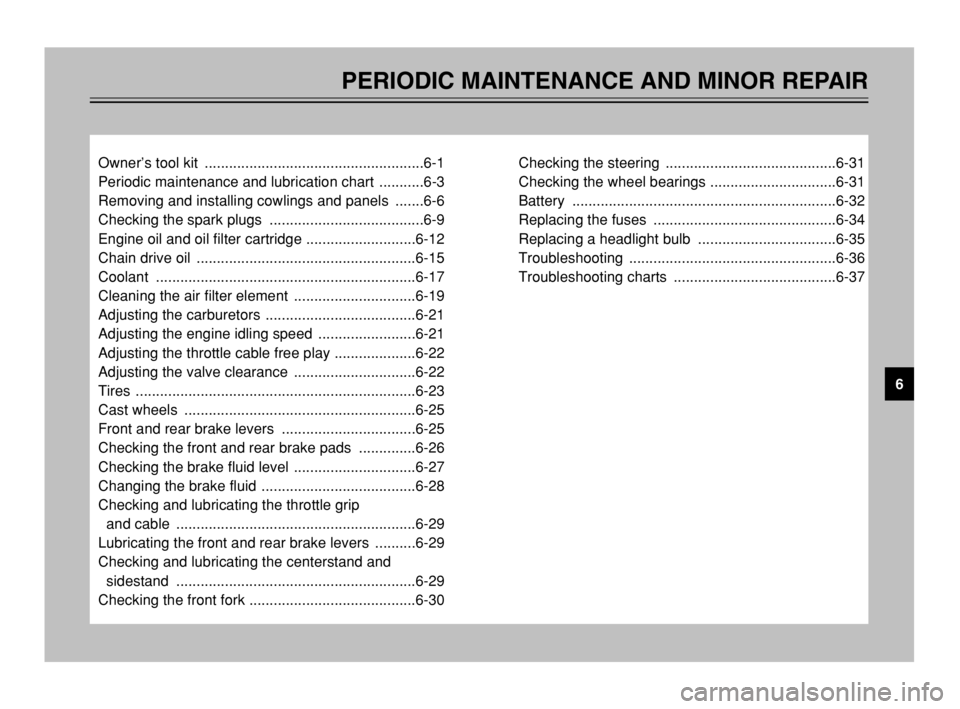wheel YAMAHA TMAX 2003 Owners Manual
[x] Cancel search | Manufacturer: YAMAHA, Model Year: 2003, Model line: TMAX, Model: YAMAHA TMAX 2003Pages: 104, PDF Size: 1.67 MB
Page 37 of 104

4-2
PRE-OPERATION CHECKS
4
NOTE:
Pre-operation checks should be made each time the scooter is used. Such an inspection can be accomplished in a very
short time; and the added safety it assures is more than worth the time involved.
EWA00033
w
If any item in the Pre-operation check list is not working properly, have it inspected and repaired before operat-
ing the scooter.
Throttle grip•Make sure that operation is smooth.
•Check cable free play.
•If necessary, have Yamaha dealer adjust cable free play and lubricate cable and
grip housing.6-22, 6-29
Wheels and tires•Check for damage.
•Check tire condition and tread depth.
•Check air pressure.
•Correct if necessary.6-23–6-25
Brake levers•Make sure that operation is smooth.
•Lubricate lever pivoting points if necessary.3-9, 6-29
Centerstand, sidestand•Make sure that operation is smooth.
•Lubricate pivots if necessary.6-29–6-30
Chassis fasteners•Make sure that all nuts, bolts and screws are properly tightened.
•Tighten if necessary.—
Instruments, lights, signals
and switches•Check operation.
•Correct if necessary.3-2–3-8, 6-35–6-36
Sidestand switch•Check operation of ignition circuit cut-off system.
•If system is defective, have Yamaha dealer check vehicle.3-14–3-16 ITEM CHECKS PAGE
5GJ-28199-E2 9/9/02 9:15 AM Page 35
Page 40 of 104

5-1
EAU00372
OPERATION AND IMPORTANT RIDING POINTS
5
EAU03981
w
8 8
Become thoroughly familiar
with all operating controls and
their functions before riding.
Consult a Yamaha dealer
regarding any control or func-
tion that you do not thorough-
ly understand.
8 8
Never start the engine or oper-
ate it in a closed area for any
length of time. Exhaust fumes
are poisonous, and inhaling
them can cause loss of con-
sciousness and death within a
short time. Always make sure
that there is adequate ventila-
tion.
8 8
For safety, always start the
engine with the centerstand
down.
8 8
When the centerstand is down
and the engine is idling, keep
your hands and feet away from
the rear wheel.
EAU03843
Starting the engineStarting the engine
EC000046
cC
See page 5-4 for engine break-in
instructions prior to operating the
vehicle for the first time.
In order for the ignition circuit cut-off
system to enable starting, the side-
stand must be up.
EW000054
w
8 8
Before starting the engine,
check the function of the igni-
tion circuit cut-off system
according to the procedure
described on page 3-16.
8 8
Never ride with the sidestand
down.
1. Turn the key to “ON” and make
sure that the engine stop switch
is set to “#”.
2. Close the throttle completely.
3. Start the engine by pushing the
start switch while applying the
front or rear brake.
NOTE:
If the engine does not start, release
the start switch, wait a few seconds,
and then try again. Each starting
attempt should be as short as possi-
ble to preserve the battery. Do not
crank the engine more than
10 seconds on any one attempt. If
the engine does not start, try with the
throttle open 1/8 turn.
ECA00045
cC
For maximum engine life, never
accelerate hard when the engine is
cold!
5GJ-28199-E2 9/9/02 9:15 AM Page 38
Page 45 of 104

PERIODIC MAINTENANCE AND MINOR REPAIR
Owner’s tool kit ......................................................6-1
Periodic maintenance and lubrication chart ...........6-3
Removing and installing cowlings and panels .......6-6
Checking the spark plugs ......................................6-9
Engine oil and oil filter cartridge ...........................6-12
Chain drive oil ......................................................6-15
Coolant ................................................................6-17
Cleaning the air filter element ..............................6-19
Adjusting the carburetors .....................................6-21
Adjusting the engine idling speed ........................6-21
Adjusting the throttle cable free play ....................6-22
Adjusting the valve clearance ..............................6-22
Tires .....................................................................6-23
Cast wheels .........................................................6-25
Front and rear brake levers .................................6-25
Checking the front and rear brake pads ..............6-26
Checking the brake fluid level ..............................6-27
Changing the brake fluid ......................................6-28
Checking and lubricating the throttle grip
and cable ...........................................................6-29
Lubricating the front and rear brake levers ..........6-29
Checking and lubricating the centerstand and
sidestand ...........................................................6-29
Checking the front fork .........................................6-30Checking the steering ..........................................6-31
Checking the wheel bearings ...............................6-31
Battery .................................................................6-32
Replacing the fuses .............................................6-34
Replacing a headlight bulb ..................................6-35
Troubleshooting ...................................................6-36
Troubleshooting charts ........................................6-37
6
5GJ-28199-E2 9/9/02 9:15 AM Page 43
Page 49 of 104

6-4
PERIODIC MAINTENANCE AND MINOR REPAIR
6
8*Rear brake•Check operation, fluid level and vehicle for fluid leakage.
(See NOTE on page 6-5.)√√√√√ √
•Replace brake pads.Whenever worn to the limit
9
*Brake hoses•Check for cracks or damage.√√√√ √
•Replace. (See NOTE on page 6-5.)Every 4 years
10
*Wheels•Check runout and for damage.√√√√
11
*Tires•Check tread depth and for damage.
•Replace if necessary.
•Check air pressure.
•Correct if necessary.√√√√ √
12
*Wheel bearings•Check bearing for looseness or damage.√√√√
13
*Steering bearings•Check bearing play and steering for roughness.√√√√√
•Lubricate with lithium-soap-based grease.Every 20,000 km
14
*Chassis fasteners•Make sure that all nuts, bolts and screws are properly tightened.√√√√ √
15 Sidestand, centerstand•Check operation.
•Lubricate.√√√√ √
16
*Sidestand switch•Check operation.√√√√√ √
17
*Front fork•Check operation and for oil leakage.√√√√
18
*Shock absorber
assembly•Check operation and shock absorber for oil leakage.√√√√
19
*Carburetors•Adjust engine idling speed and synchronization.√√√√√ √ NO. ITEM CHECK OR MAINTENANCE JOBODOMETER READING (× 1,000 km)
ANNUAL
CHECK
1 10203040
5GJ-28199-E2 9/9/02 9:15 AM Page 47
Page 69 of 104

6-24
PERIODIC MAINTENANCE AND MINOR REPAIR
6 Tire inspection
The tires must be checked before
each ride. If the center tread depth
reaches the specified limit, if the tire
has a nail or glass fragments in it, or
if the sidewall is cracked, have a
Yamaha dealer replace the tire imme-
diately.
NOTE:
The tire tread depth limits may differ
from country to country. Always com-
ply with the local regulations.
1a
1. Tire sidewall
a. Tire tread depth
EAU00683
w
8 8
Have a Yamaha dealer replace
excessively worn tires.
Besides being illegal, operat-
ing the scooter with exces-
sively worn tires decreases
riding stability and can lead to
loss of control.
8 8
The replacement of all wheel
and brake related parts,
including the tires, should be
left to a Yamaha dealer, who
has the necessary profession-
al knowledge and experience.
Tire information
This scooter is equipped with cast
wheels and tubeless tires.
EW000078
w
8 8
The front and rear tires should
be of the same make and
design, otherwise the handling
characteristics of the scooter
cannot be guaranteed.
8 8
After extensive tests, only the
tires listed below have been
approved for this model by
Yamaha Motor Co., Ltd.
Minimum tire tread depth
(front and rear)1.6 mm
FRONT
Manufacturer Size Model
DUNLOP 120/70-14M/C 55S D305FA
BRIDGESTONE120/70-14M/C 55S HOOP B03
REAR
Manufacturer Size Model
DUNLOP 150/70-14M/C 66S D305
BRIDGESTONE150/70-14M/C 66S HOOP B02
5GJ-28199-E2 9/9/02 9:15 AM Page 67
Page 70 of 104

6-25
PERIODIC MAINTENANCE AND MINOR REPAIR
6
EAU03773
Cast wheelsWheels
To maximize the performance, dura-
bility, and safe operation of your
scooter, note the following points
regarding the specified wheels.
8The wheel rims should be
checked for cracks, bends or
warpage before each ride. If any
damage is found, have a
Yamaha dealer replace the
wheel. Do not attempt even the
smallest repair to the wheel. A
deformed or cracked wheel must
be replaced.
8The wheel should be balanced
whenever either the tire or wheel
has been changed or replaced.
An unbalanced wheel can result
in poor performance, adverse
handling characteristics, and a
shortened tire life.
EAU03851
Front and rear brake levers
There should be no free play at the
brake lever ends. If there is free play,
have a Yamaha dealer inspect the
brake system.
8Ride at moderate speeds after
changing a tire since the tire sur-
face must first be “broken in” for
it to develop its optimal charac-
teristics.FRONT
5GJ-28199-E2 9/9/02 9:15 AM Page 68
Page 76 of 104

6-31
PERIODIC MAINTENANCE AND MINOR REPAIR
6
EAU00794
Checking the steeringSteering, checking
Worn or loose steering bearings may
cause danger. Therefore, the opera-
tion of the steering must be checked
as follows at the intervals specified in
the periodic maintenance and lubrica-
tion chart.
1. Place a stand under the engine
to raise the front wheel off the
ground.
EW000115
w
Securely support the scooter so
that there is no danger of it falling
over.
EAU01144
Checking the wheel bearingsWheel bearings, checking
The front and rear wheel bearings
must be checked at the intervals
specified in the periodic maintenance
and lubrication chart. If there is play
in the wheel hub or if the wheel does
not turn smoothly, have a Yamaha
dealer check the wheel bearings.
2. Hold the lower ends of the front
fork legs and try to move them
forward and backward. If any
free play can be felt, have a
Yamaha dealer check or repair
the steering.
5GJ-28199-E2 9/9/02 9:15 AM Page 74
Page 86 of 104

7-1
EAU03873
SCOOTER CARE AND STORAGE
7
CareCare
While the open design of a scooter
reveals the attractiveness of the tech-
nology, it also makes it more vulnera-
ble. Rust and corrosion can develop
even if high-quality components are
used. A rusty exhaust pipe may go
unnoticed on a car, however, it
detracts from the overall appearance
of a scooter. Frequent and proper
care does not only comply with the
terms of the warranty, but it will also
keep your scooter looking good,
extend its life and optimize its perfor-
mance.Before cleaning
1. Cover the muffler outlet with a
plastic bag after the engine has
cooled down.
2. Make sure that all caps and cov-
ers as well as all electrical cou-
plers and connectors, including
the spark plug cap, are tightly
installed.
3. Remove extremely stubborn dirt,
like oil burnt onto the crankcase,
with a degreasing agent and a
brush, but never apply such
products onto seals, gaskets and
wheel axles. Always rinse the dirt
and degreaser off with water.CleaningECA00011
cC
8
8
Avoid using strong acidic
wheel cleaners, especially on
spoked wheels. If such prod-
ucts are used on hard-to-
remove dirt, do not leave the
cleaner on the affected area
any longer than instructed.
Also, thoroughly rinse the area
off with water, immediately dry
it, and then apply a corrosion
protection spray.
8 8
Improper cleaning can damage
windshields, cowlings, panels
and other plastic parts. Use
only a soft, clean cloth or
sponge with mild detergent
and water to clean plastic.
5GJ-28199-E2 9/9/02 9:15 AM Page 84
Page 87 of 104

7-2
SCOOTER CARE AND STORAGE
7 8 8
Do not use any harsh chemical
products on plastic parts. Be
sure to avoid using cloths or
sponges which have been in
contact with strong or abra-
sive cleaning products, sol-
vent or thinner, fuel (gasoline),
rust removers or inhibitors,
brake fluid, antifreeze or elec-
trolyte.
8 8
Do not use high-pressure
washers or steam-jet cleaners
since they cause water seep-
age and deterioration in the
following areas: seals (of
wheel and swingarm bearings,
fork and brakes), electric com-
ponents (couplers, connec-
tors, instruments, switches
and lights), breather hoses
and vents.8 8
For scooters equipped with a
windshield: Do not use strong
cleaners or hard sponges as
they will cause dulling or
scratching. Some cleaning
compounds for plastic may
leave scratches on the wind-
shield. Test the product on a
small hidden part of the wind-
shield to make sure that it
does not leave any marks. If
the windshield is scratched,
use a quality plastic polishing
compound after washing.After normal use
Remove dirt with warm water, a mild
detergent, and a soft, clean sponge,
and then rinse thoroughly with clean
water. Use a toothbrush or bottle-
brush for hard-to-reach areas.
Stubborn dirt and insects will come
off more easily if the area is covered
with a wet cloth for a few minutes
before cleaning.After riding in the rain, near the sea
or on salt-sprayed roads
Since sea salt or salt sprayed on
roads during winter are extremely
corrosive in combination with water,
carry out the following steps after
each ride in the rain, near the sea or
on salt-sprayed roads.
NOTE:
Salt sprayed on roads in the winter
may remain well into spring.
1. Clean the scooter with cold water
and a mild detergent after the
engine has cooled down.
ECA00012
cC
Do not use warm water since it
increases the corrosive action of
the salt.
2. Apply a corrosion protection
spray on all metal, including
chrome- and nickel-plated, sur-
faces to prevent corrosion.
5GJ-28199-E2 9/9/02 9:15 AM Page 85
Page 90 of 104

7-5
SCOOTER CARE AND STORAGE
75. Lubricate all control cables and
the pivoting points of all levers
and pedals as well as of the
sidestand/centerstand.
6. Check and, if necessary, correct
the tire air pressure, and then lift
the scooter so that both of its
wheels are off the ground.
Alternatively, turn the wheels a
little every month in order to pre-
vent the tires from becoming
degraded in one spot.
7. Cover the muffler outlet with a
plastic bag to prevent moisture
from entering it.8. Remove the battery and fully
charge it. Store it in a cool, dry
place and charge it once a
month. Do not store the battery
in an excessively cold or warm
place (less than 0 °C or more
than 30 °C). For more informa-
tion on storing the battery, see
page 6-33.
NOTE:
Make any necessary repairs before
storing the scooter.
5GJ-28199-E2 9/9/02 9:15 AM Page 88